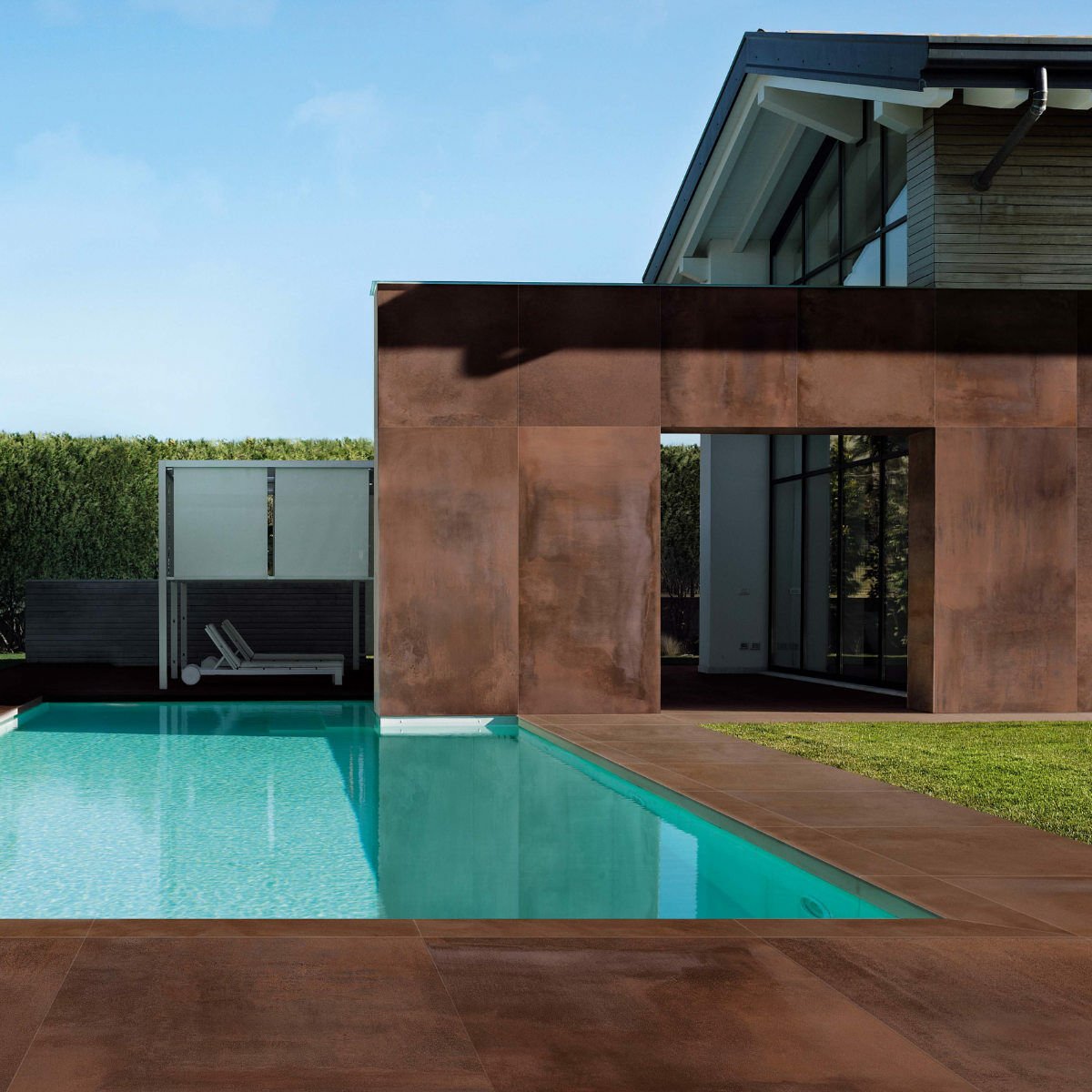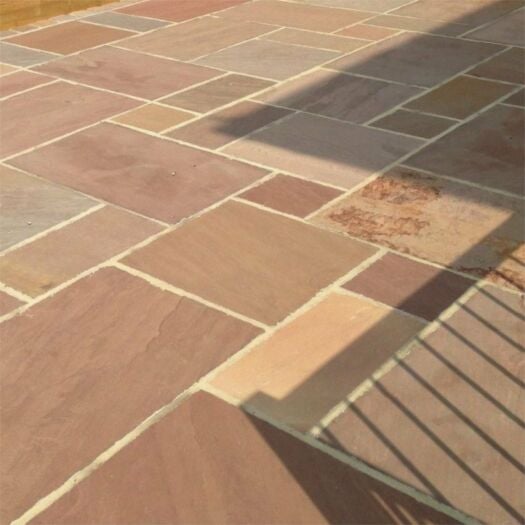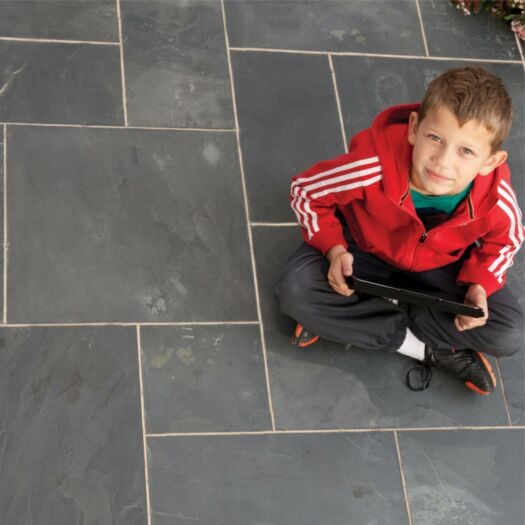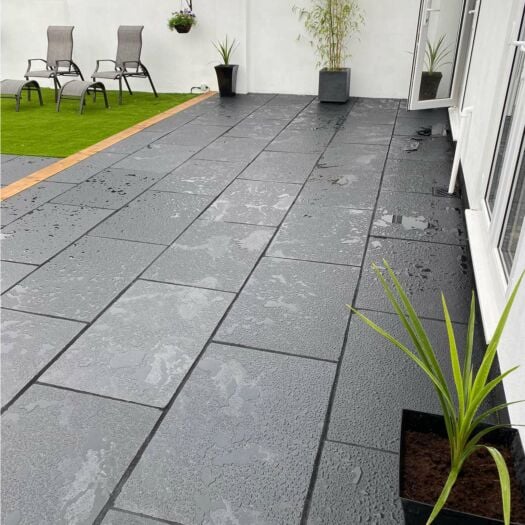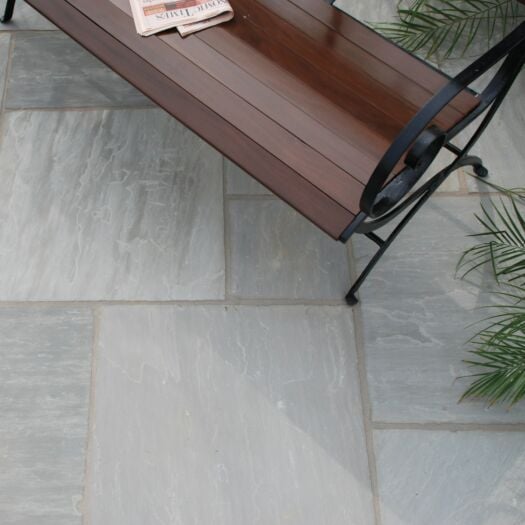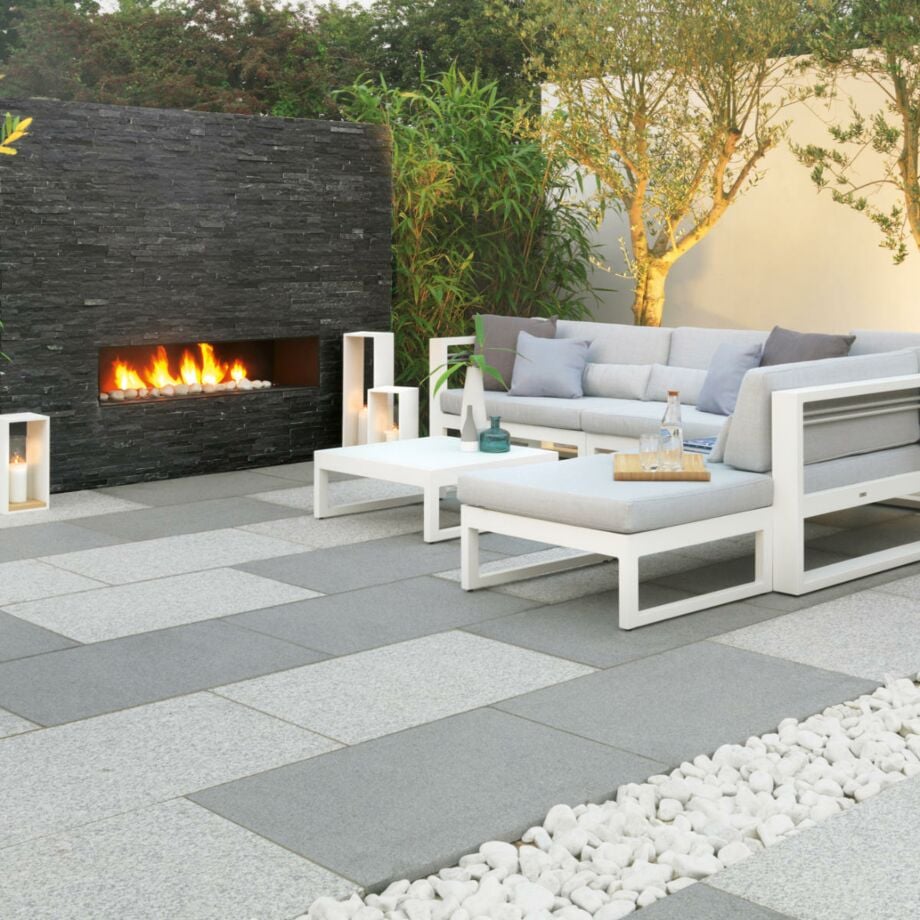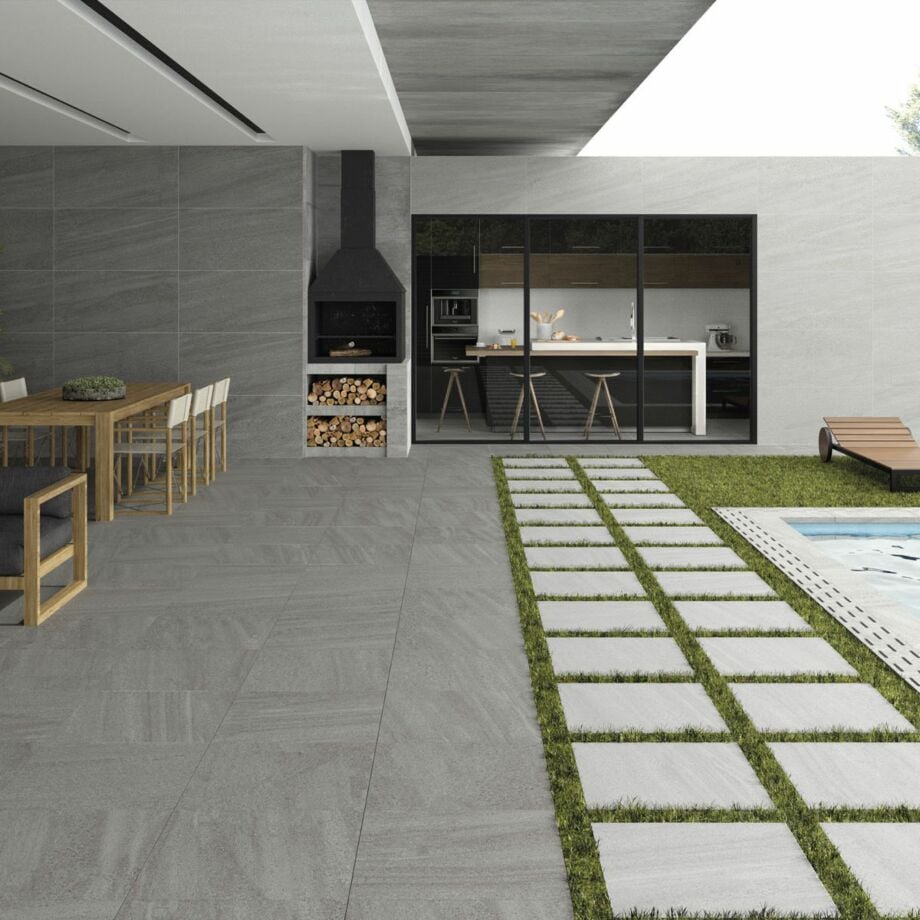
Designing a new patio can be an exciting project that adds value to your home while creating a practical and aesthetically pleasing outdoor living space. Patios can serve as extensions of your home, attached to it, or located in separate areas of your garden to suit your lifestyle, the time of day, and the position of the sun. Installing a new patio has several advantages. It can enhance the aesthetic appeal of your outdoor space, increase your property's value, provide a functional and versatile outdoor living space for various activities, create a sense of privacy, and require minimal maintenance compared to other outdoor living spaces.
Choosing the best paving for your patio can be a daunting task, given the many options available, including natural stone, concrete, and porcelain. To help you decide, we will explain the pros and cons of each type of paving. But first, you need to consider some initial factors that can influence your decision.
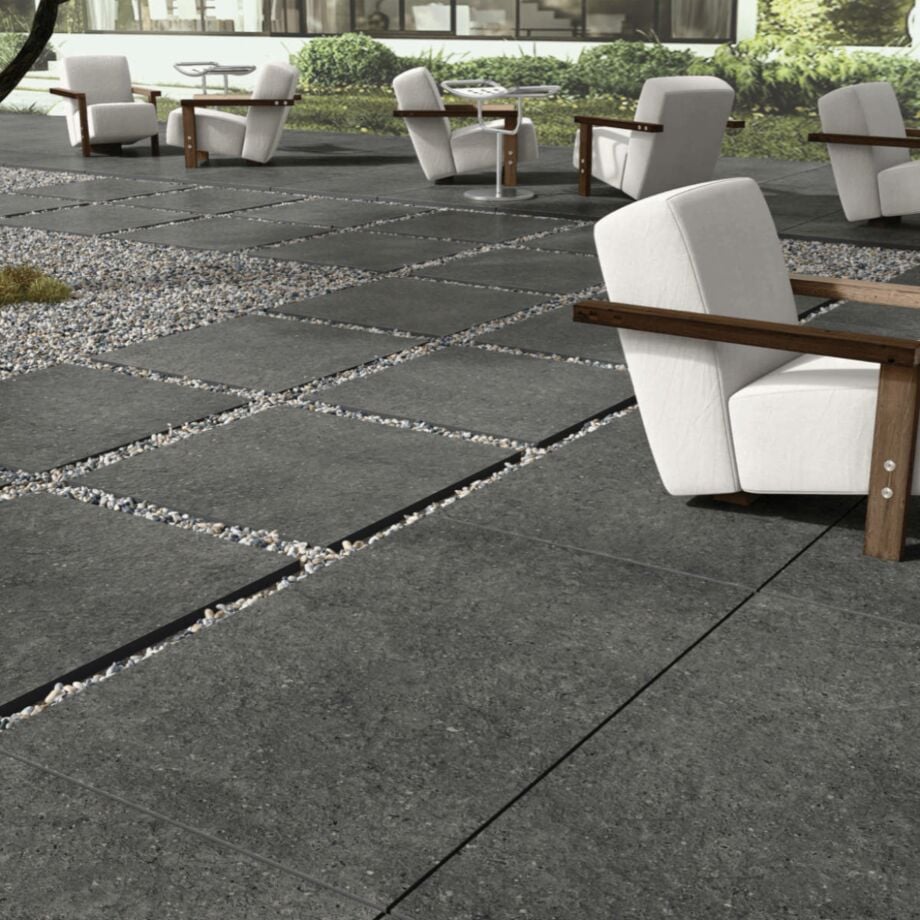
Appearance & Design
The paving design of your outdoor space should harmonise with the interior design of your home. If your home boasts a contemporary style, your patio and garden design should naturally follow suit. It's a popular trend to extend indoor style to the outdoors, especially with porcelain paving. However, you can also use other stone types like slate or modern clay pavers, which work well in both settings. To create a seamless flow between indoors and out, use the same colour scheme and accent colours for both areas.
In addition to interior design, the style of your home's exterior should also guide your patio design. It's important to choose colours and materials that complement your home's exterior features, such as windows, doors, roof tiles, and brickwork or render colours. This ensures that your patio design and garden features blend well with the rest of your property. Remember, the patio is not an isolated feature, but rather an extension of your home that frames its exterior.
If you're replacing an existing patio, it's a great opportunity to re-evaluate its design and functionality. You may want to reconsider the location of your hardstanding area if it's constantly in the shade. Instead, create a larger patio in a sunnier area of your garden to serve as your primary seating area for relaxation and entertaining. Take the time to think about how you use your garden and make changes as necessary to enhance your outdoor living experience.
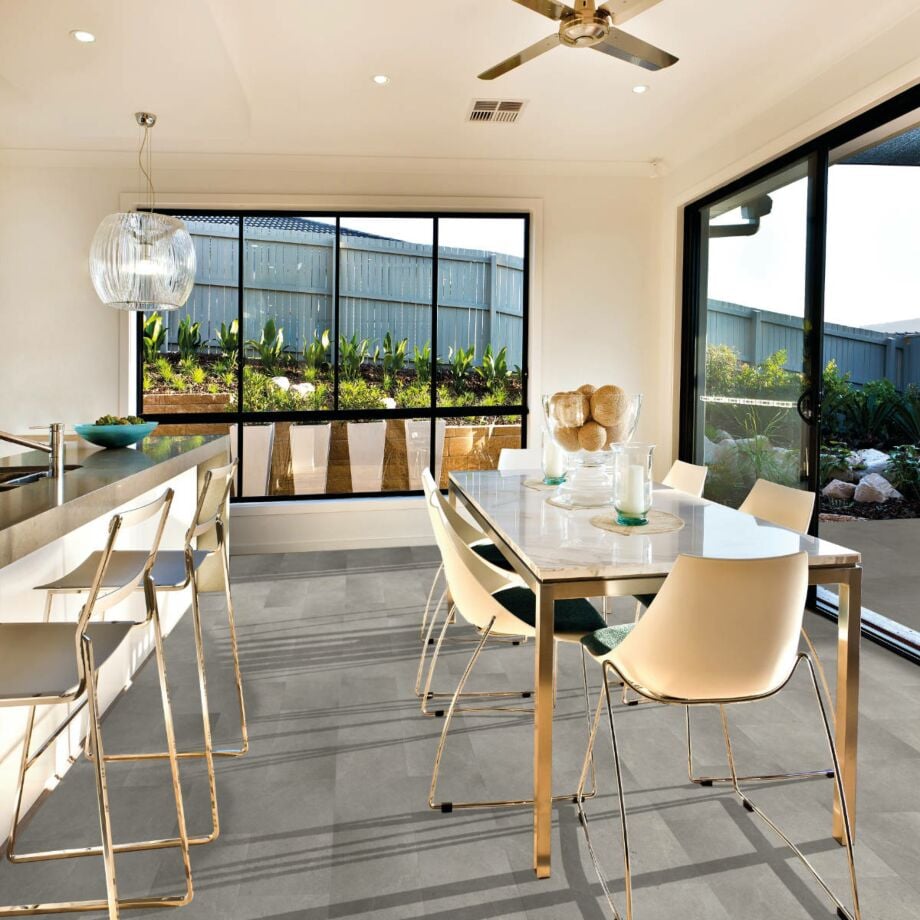
Colour & Texture
When choosing paving for your home, the colour and texture you choose will impact the types of paving available to you. As previously noted, the colour and style of your paving should be primarily determined by the clues within your home.
Contemporary garden styles typically feature simple, plain colours such as grey, black, and light cream, with feature areas of mosaic patterned tiles or woodstyle paving to add interest to a larger area. A typical contemporary texture would be smooth or lightly textured, with a flat surface for a simple yet elegant design. Porcelain, granite, sawn sandstone, and slate are the types of paving stone frequently seen in contemporary gardens.
On the other hand, more traditional garden patio styles tend to feature natural tones of paving with a natural handsplit riven surface or a tumbled or aged finish. These styles complement the rustic appearance of an older style property, with irregular finishes and gentle mixes of colours that blend well with a natural, more organic feel. Sandstone, limestone, and slate are the types of stone suited to traditional styles.
The laying patterns you use can also create a perception of texture. For instance, using a natural riven surface paving slab in a single large format size and a stretcher bond pattern will give a contemporary appearance, even though the stone itself is typically considered more traditional. Similarly, a random paving pattern gives the appearance of a more traditional style. It's crucial to note that the appearance of individual paving slabs is different from the appearance when seen en masse over a wide area.
Texture can be created by adding smaller format paving, such as an area of cobble setts that will add textured interest or a breakout section using linear plank paving that draws the eye to that section.
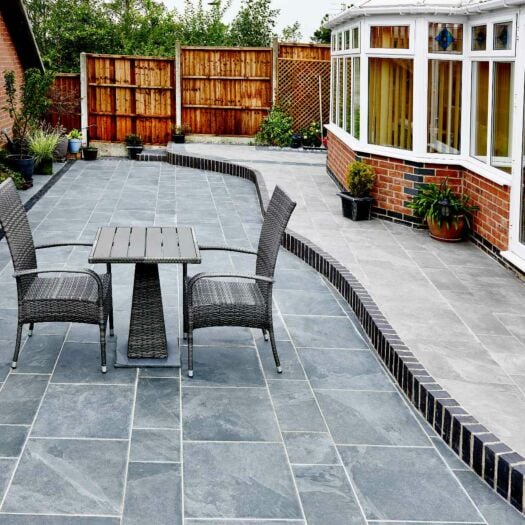 |
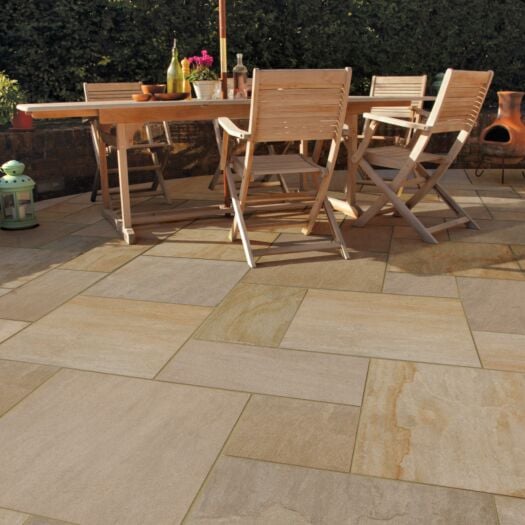 |
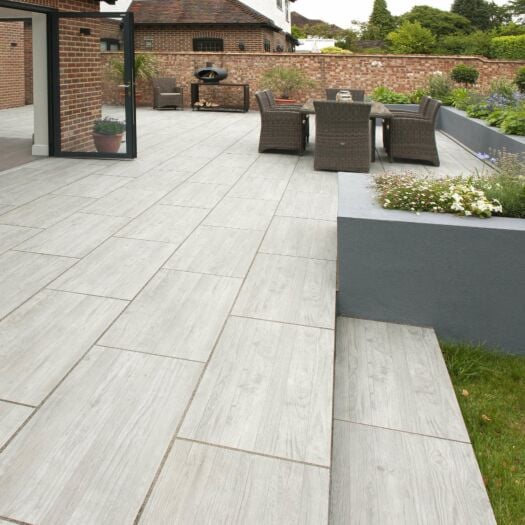 |
Durability & Maintenance
At Paving Superstore, we pride ourselves on offering high-quality paving that meets British UKCA Standards and comes with a Declaration of Performance certificate. Our paving is rigorously tested for durability, freeze resistance, slip rating, and breaking strength to ensure long-lasting performance. Unlike many online retailers who offer subpar products that fail to meet these standards, we understand that not all paving is created equal. Natural stone, in particular, can vary greatly in terms of porosity, softness, and brittleness, which can lead to excessive algae growth, cracking in frost, crumbling, or breaking.
In addition to choosing the right type of stone, maintenance is another crucial factor to consider. Porcelain paving, with its low porosity, is the easiest to care for, as it doesn't absorb stains as readily as more porous stones. However, even porcelain can stain if organic matter is left on its surface for too long. To prevent this, it's essential to sweep away any leaves or debris regularly and use an organic cleaner like Pavetuf Greenoff if stains do occur.
When it comes to sandstone, lighter colours are more prone to algae staining than darker shades due to their higher porosity. Opting for a grey or slightly darker tone can be a lower maintenance option. Granite and slate are excellent choices for those who prioritise stain resistance, as they are high-density materials that are less porous. Marble, and travertine require more maintenance and may be more prone to algae growth, especially if they have a pitted surface. Limestone in the lighter buff tones is easy to care for whereas the darker black limestone will gradually fade to a mid grey colour. To retain and restore the dark colour, treat with a product such as Pavetuf Back to Black.
At Paving Superstore, we believe that choosing the right type of paving and following proper maintenance procedures are critical to ensuring the longevity and beauty of your outdoor living space.
Ethics & Sustainability
The paving industry is increasingly recognising the importance of sustainability, with manufacturers and consumers alike placing a greater emphasis on environmentally responsible practices. One key area of focus is the manufacturing process, where efforts are being made to reduce the carbon footprint associated with the production of paving products. Sustainable manufacturing practices may involve the use of recycled materials, the implementation of energy-efficient production techniques, and the reduction of waste and emissions.
Determining the most sustainable paving option depends on the specific circumstances and priorities of the project, considering factors such as the materials used, the production process, and the end-of-life disposal options. It is worth noting that paving produced locally is not necessarily the most sustainable option, and that natural stone may be more sustainable than concrete paving.
Additionally, the length of service that a product can provide is a significant factor to consider, as it makes it more sustainable than other throwaway products and food, for example.
At Paving Superstore, we prioritise sustainability by partnering with companies that belong to the Ethical Trading Initiative or similar organisations. These partnerships ensure that employment is freely chosen, a living wage is paid, and suitable sanitary and safety facilities are provided.
Prices & Budget
Paving a patio can be a significant investment, but it's a great way to enhance the look and functionality of your outdoor space. When it comes to pricing and budgeting for a patio project, there are several factors to consider.
The first factor to consider is the size of your patio. Naturally, the larger the patio, the more material you'll need, which will impact the overall cost. The type of material you choose will also affect the cost, with some materials being more expensive than others.
Another factor to consider is the complexity of the design. If you opt for a simple, straight-lined design, the cost will be less than if you choose a more intricate design with curves, patterns, and borders. Additionally, the cost of labour will depend on the complexity of the design, as well as the experience and expertise of the installer.
It's also important to note that the cost of the paving usually only represents around 20% of the overall cost of the project. As a guide to prices, riven sandstone ranges from around £20-£30 per m2 with mixed size packs offering the best value, and porcelain from around £25 upwards depending upon paver size with the 600x600mm size being the best price.
When it comes to budgeting for your patio project, it's important to set a realistic budget and stick to it. Consider all of the factors mentioned above, as well as any additional costs such as excavation, drainage, and lighting. Be sure to get quotes from multiple contractors to compare prices and find the best value for your money.
It's also worth considering financing options if you don't have the cash on hand to pay for the project upfront. At Paving Superstore we offer Klarna finance to spread the cost or Trade Finance for customers with a Paving Superstore Trade Account. Some contractors offer financing options, or you could consider taking out a personal loan. Just be sure to factor in the cost of interest when budgeting for your project.
Characteristics of Different Stone Types
Natural stone paving:
Natural stone includes sandstone, limestone, slate, granite, marble and other more unusual paving materials such as quartzite, porphyry and schist. All natural stone paving is versatile and durable and offers several advantages, but it also has some potential drawbacks. Here's a look at the pros and cons of natural stone paving.
Pros:
-
Aesthetic appeal: Natural stone is prized for its unique and beautiful appearance. With a wide range of colours, textures, and patterns to choose from, homeowners can create a custom look that complements their landscaping and architecture.
-
Durability: Natural stone is a highly durable material that can withstand heavy use and extreme weather conditions. It is resistant to chipping, cracking, and erosion, making it a great choice for high-traffic areas.
-
Low maintenance: Natural stone is relatively low maintenance, requiring only occasional cleaning and sealing to maintain its appearance and durability.
-
Environmentally friendly: Natural stone is a sustainable and eco-friendly option as it is a natural material that is quarried from the earth.
- Weight: Owing to the strength of natural stone, it can be cut thinner at around 20mm which makes it easier to handle.
-
Cost: Natural stone with a handsplit riven surface is generally are more econimcally priced option than all other paving types.
Cons:
-
Cost: Natural stone with specialist finishes such as sandblasting or tumbling is often a more expensive option compared to other finishes such as a natural handsplit surface. The cost will vary based on the type of stone and the difficulty of manufacturing.
-
Colour variation: Some natural stones such as sandstone can have inconsistent colouring and whilst one batch may have a broad variety of shades, another batch of the same stone may be quite plain in appearance.
-
Characteristics: Most types of natural stone may have characteristics such as fissures, veins, iron and mineral deposits which are sometimes attractive and a feature of natural stone, but can be considered unsightly be some people.
-
Maintenance: While natural stone is low maintenance, it may require more care than other materials. Certain types of stone may need to be sealed more frequently, and spills should be cleaned up promptly to prevent staining.
Types of natural stone paving:
- Sandstone: This type of paving comes in a broad range of colour options from lightest ivory and grey through to grey green, beige, pink, brown and dark grey. Whilst there will always be predominant shades within each colour range, there will also be a selection of complementary shades that are pastel toned when dry and rich in colour when wet. Sandstone comes in a variety of different finishes including natural handsplit riven through to sawn flat with a choice of texture finishes such as sandblasted and flamed. Overall, sandstone is a hardwearing stone that offers excellent value for money
- Limestone: Similar to sandstone in appearance, limestone is a popular good value choice available in a choice of four main colours: buff, blue-grey, grey and black. With black limestone, the colour fades to a miod grey in sunlight, but can be restored back to the dark coloured if preferred.
- Slate: The dark coloured stone comes in either. a blue black shade of a green grey colour. It has a relatively flat surface with sawn straight edges and although it's not the best value natural stone, it's a classic choice that works well with both contemporary and traditional style gardens.
- Granite: Granite paving is ideal as a contemporary choice paving material with its lightly flecked appearance, it works well where a modern, uniform appearance is required. As a general rule, granite paving is moderately priced, but varies dependant upon colour with the darker shades being more expensive.
|
Sandstone |
Slate |
Limestone |
Sandstone |
Granite |
Concrete paving:
Concrete paving is a popular choice for many outdoor projects, including driveways, patios, and walkways. Concrete is a durable and versatile material that offers several advantages, but it also has some potential drawbacks. Here's a look at the pros and cons of concrete paving.
Pros:
-
Durability: Concrete is a highly durable material that can withstand heavy use and extreme weather conditions. It is resistant to cracking, chipping, and erosion, making it a great choice for high-traffic areas.
-
Versatility: Concrete can be moulded into almost any shape or size to create a wide range of designs and colours. This versatility allows homeowners to create unique and customised outdoor spaces that reflect their personal style.
-
Low maintenance: Concrete is relatively low maintenance, requiring only occasional cleaning and sealing to maintain its appearance and durability.
-
Cost-effective: Concrete is often a cost-effective option compared to other materials like natural stone or brick.
Cons:
-
Cracking: Although concrete is highly durable, it is not immune to cracking. Extreme temperature changes, heavy loads, and settling of the underlying soil can cause cracks to develop over time.
-
Slipperiness: When wet, concrete can become slippery, making it a potential safety hazard for high-traffic areas like driveways and walkways.
-
Limited aesthetic options: While concrete can be customised with different colours and designs, it may not have the same aesthetic appeal as natural stone or other premium paving materials.
-
Environmental impact: The production of concrete can have a significant environmental impact due to the high energy requirements and carbon emissions associated with the manufacturing process.
- Weight: To maintain the required durability, concrete has to be produced as a thicker unit making it heavier to handle.
-
Colours: Concrete paving is manufactured from naturally occurring aggregates and is often dyed to a specific colour. This will gradually fade over time.
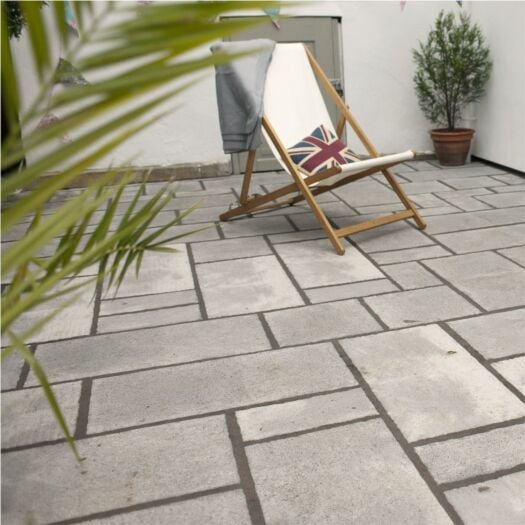 |
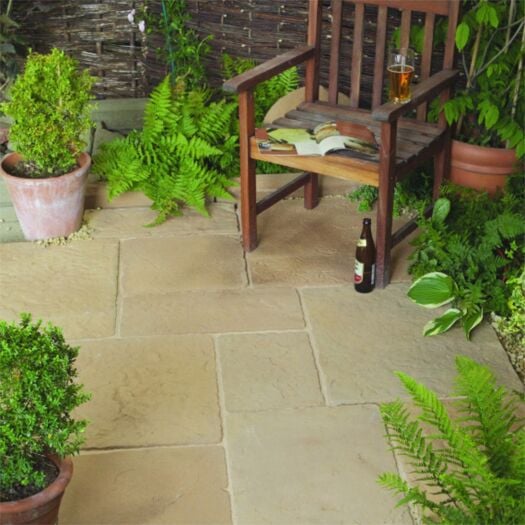 |
Porcelain paving:
Porcelain paving is a relatively new option for outdoor projects, including patios, walkways, and pool decks. Porcelain is a mix of clays that have been specially manufactured under intense heat to be used as an outdoor paving option. Here's a look at the pros and cons of porcelain paving.
Pros:
-
Aesthetic appeal: Porcelain paving offers a sleek and modern look that complements contemporary architecture and design. It is available in a wide range of colours and textures, and it can mimic the look of natural stone or wood.
-
Durability: Porcelain is a highly durable material that is resistant to chipping, cracking, and staining. It is also resistant to frost, fading, and other weather conditions, making it a great choice for outdoor use.
-
Low maintenance: Porcelain paving is relatively low maintenance, requiring only occasional cleaning and sweeping to maintain its appearance and durability.
-
Slip resistance: Porcelain paving has a textured surface that provides excellent slip resistance, even when wet.
Cons:
-
Cost: Porcelain paving is often a more expensive option compared to other materials like concrete or natural stone. The cost will vary based on the type of porcelain and the size of the individual pavers.
-
Installation: Porcelain paving is a relatively new option, and some installers may not have the experience or knowledge to install it correctly. It requires skill and the correct tools to cut porcelain.
-
Environmental impact: The production of porcelain can have a significant environmental impact due to the high energy requirements and carbon emissions associated with the manufacturing process.
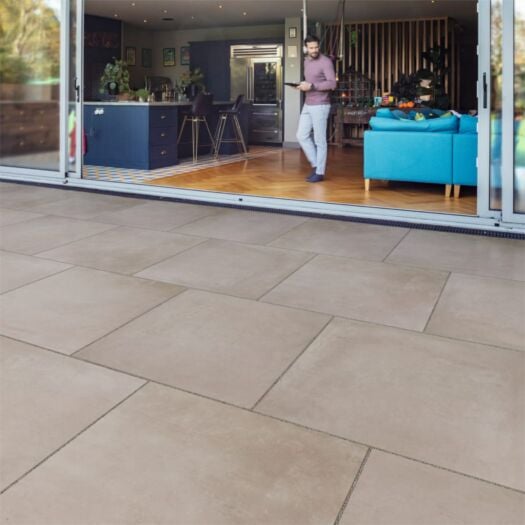 |
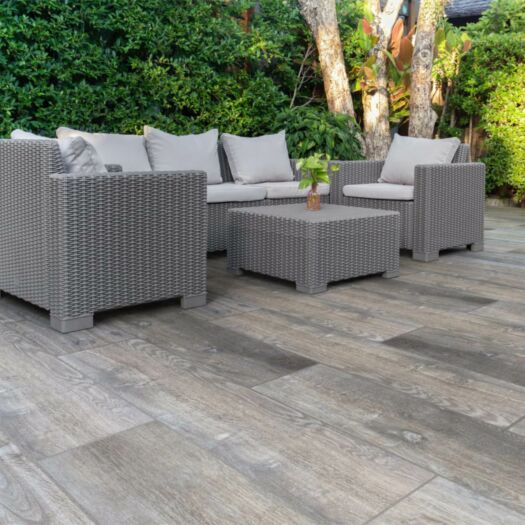 |
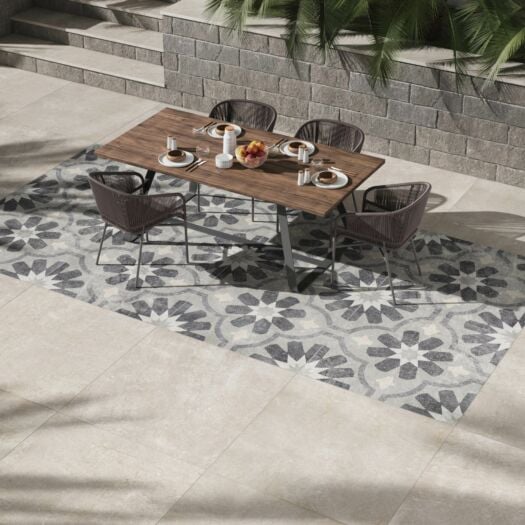 |
Conclusion
Selecting the ideal stone type for your patio may seem daunting and time-consuming, but our recommendations can assist in streamlining the process. To summarise, sandstone paving is the best value due to its wide variety of colour choices and size options. It is long-lasting, easy to maintain, and suitable for a wide range of styles. Consider mixing various sizes for traditional styles and using single individual size pavers for more contemporary styles. The colour palettes are adaptable to their surroundings, making them a simple choice for most homeowners. Porcelain offers an easy-care solution in a wide range of colours, but it is more suited to modern styles. Choosing a single size paver, typically a 600x600mm, is the most cost-effective approach. Limestone and slate are both timeless and classic, especially when darker colours are required, although slate is a little more expensive.
Ultimately, selecting the perfect paving for your project is a personal decision, but we hope our advice has provided some direction. Take the time to assess your requirements, preferences, and budget before making a final decision, and don't hesitate to seek advice from a professional if necessary.
